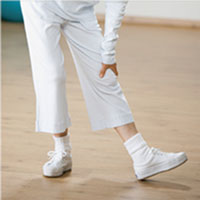Knee Pain and Your Exercise Routine
Most osteoarthritis knee pain sufferers know that exercise is a crucial part of treatment. Unfortunately, many get caught in what's known as the vicious cycle of knee pain. Your knee hurts, so you start avoiding activities and exercise, which can lead to weight gain and more knee pain.
How do exercise and knee pain relief go hand in hand?
"If all the benefits of exercise could be put into a single pill, it would be the most widely prescribed medicine in the world," says Dr. Nicholas DiNubile, an orthopedic surgeon specializing in sports medicine.
But it's hard to exercise when you're in pain. The sooner you find a treatment that relieves your osteoarthritis knee pain, the sooner you may get back to the exercises that benefit your knees most.

Are some exercises better than others for knees with osteoarthritis?
Dr. DiNubile responds: Overall, exercise is wonderful for joints with osteoarthritis, but not all exercise is created equal. In general, patients with knee osteoarthritis should employ lower-impact, aerobic-type activities such as walking, cycling, elliptical training or water-based exercises.
Of all the options, I think cycling is one of the best for helping to build your thigh muscles. Walking is also good, but it may be too difficult for individuals with advanced osteoarthritis. Instead, I recommend water aerobics, swimming or even using a stationary bike or elliptical machine.
Check with your doctor or physical therapist about safe and effective exercise routines that are ideal for osteoarthritis sufferers.†

I've heard a lot about stretching and range of motion exercises. What's the difference?
Dr. DiNubile responds: Stretching primarily helps the muscles, while range of motion (ROM) exercises target the joints. However, they are both extremely important for those with knee osteoarthritis.
Stretching is often neglected in our workouts. Most of us need to stretch more, especially as we age. It's best to stretch after a good warm up and after your workout is concluded.
The purpose of warming up is to get blood flowing to your muscles and to raise your body temperature. Warmed-up muscles will behave more elastically and are less likely to be injured or strained. A warm up can be simply one or two minutes of calisthenics like jumping jacks, running in place or a brief ride on a stationary bike.
Joint ROM exercises help keep mobility in the joint and prevent the stiffness and motion loss that is so common with osteoarthritis.
To improve or maintain joint mobility, gently and slowly flex (bend) the joint as much as possible and hold 10–20 seconds, then extend (straighten) the joint and hold for another 10–20 seconds.
Stretching and ROM exercises should be static, which means no bouncy movements.†
Which treatment can help relieve your osteoarthritis knee pain?
If you've tried exercise and over-the-counter pain relievers and haven’t found enough knee pain relief, Synvisc-One® (hylan G-F 20) could help.
Synvisc-One is the #1 prescribed viscosupplement; it provides up to six months of osteoarthritis knee pain relief with just one injection.* A viscosupplement injection is made from a natural substance that lubricates and cushions the joint.
* As shown in a medical study comparing Synvisc-One to an injection of salt water.
Ask your doctor about a different type of treatment
Talk to your doctor about your knee pain today. Remember to be honest when evaluating how active you are with your knee pain. Ask if Synvisc-One is right for you.
* As shown in a medical study comparing Synvisc-One to an injection of salt water.
†The views presented herein are solely those of Dr. DiNubile, Orthopedic Surgeon. Sanofi US does not endorse Dr. DiNubile or his book, FrameWork. Dr. DiNubile is a paid advisor for Sanofi US. Be sure to consult with your own doctor before starting any exercise program or health regimen.